Terminal blocks for connecting wires, junction boxes and din rail: types and arrangement
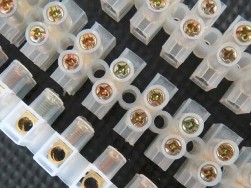 For the functioning of the wiring, you need to ensure the correct wiring diagram for it, but the assembly of the circuit does not do without connecting the wires. There are many connection methods, from twisting to welding, but perhaps the most convenient and serviceable is connecting wires with terminal blocks. In this article we will talk about what they are.
For the functioning of the wiring, you need to ensure the correct wiring diagram for it, but the assembly of the circuit does not do without connecting the wires. There are many connection methods, from twisting to welding, but perhaps the most convenient and serviceable is connecting wires with terminal blocks. In this article we will talk about what they are.
The main difference in the terminal blocks is the connection method, there are two main types. Terminals with spring or lever clamp (contact). These terminal blocks can be attributed to all the famous Wago. The veins of the conductors in them are clamped using a spring or lever mechanism, and the contact, due to its elasticity, fits snugly against the clamped vein. They are very convenient to use for connecting chandeliers, sconces and other fixtures, as well as for installing electrical wiring in distribution boxes.The main difference in the terminal blocks is the connection method ...
Why do you need a heat shrink tube: types, specifications, how to use it
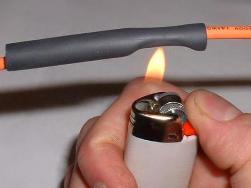 A heat shrink tube is a material for insulating electrical connections. It is used instead of electrical tape, but paired with it provides reliable and durable insulation. The principle of operation of the heat shrink tube is to change its size when heated. It is also called shrink or shrink cambric.
A heat shrink tube is a material for insulating electrical connections. It is used instead of electrical tape, but paired with it provides reliable and durable insulation. The principle of operation of the heat shrink tube is to change its size when heated. It is also called shrink or shrink cambric.
Shrinkage replaced the classic cambric. Previously, pvc cambric was used for marking and insulation of wires. For marking purposes, it was actively used in automotive wiring and relay circuits, in switchboards. On it inscriptions well kept marker or felt-tip pen. When installing household wiring in junction boxes, they were also used. In this case, cambric was put on a twist, its end was heated and squeezed with pliers, after which it was glued, and the part that was on the side of the wires was wrapped with electrical tape.Shrink is available in different colors. ...
Why wire twisting is prohibited
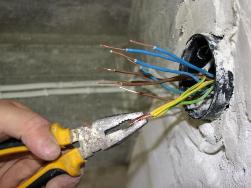 According to clause 2.1.21. PUE, connection of wires and cables should be carried out in one of the following ways: by welding, crimping, using screw or bolt connections, or by soldering in accordance with applicable instructions approved in the established manner. As you can see, the "twist" is not mentioned here at all. We can safely conclude: twisting is practically prohibited by PUE.
According to clause 2.1.21. PUE, connection of wires and cables should be carried out in one of the following ways: by welding, crimping, using screw or bolt connections, or by soldering in accordance with applicable instructions approved in the established manner. As you can see, the "twist" is not mentioned here at all. We can safely conclude: twisting is practically prohibited by PUE.
However, let's see why the official attitude to twisting is so unambiguous, what could be the reason for its exclusion from the list of permitted methods of connecting wires, because it is completely clear that this was done for a reason. Allowed: crimping, soldering, welding and screw connection. To begin with, we will consider what are the features of the allowed connection methods, and what is their difference from twisting. Soldering and welding require solidity and the highest possible conductivity of the created permanent connection ...
How to connect an induction cooker - useful tips
 When purchasing a new induction cooker, do not rush to plug it into one of the free sockets. In this case, first of all, it is necessary to determine the possibility of connecting this household appliance to a particular section of the wiring and choose the most optimal way to connect it. Consider the question of how to connect an induction cooker.
When purchasing a new induction cooker, do not rush to plug it into one of the free sockets. In this case, first of all, it is necessary to determine the possibility of connecting this household appliance to a particular section of the wiring and choose the most optimal way to connect it. Consider the question of how to connect an induction cooker.
It should be noted that before acquiring an induction cooker, it is necessary to clarify what load limit is defined for the apartment (house) and assess the possibility of operating a particular induction cooker taking into account its maximum power consumption.A desktop induction electric stove, as a rule, has a cord and a plug for connecting to a regular household outlet. That is, in this case there is no need to purchase an additional cord and plug ...
How not to get into the wire when drilling walls
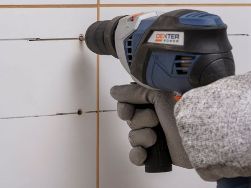 Drilling walls and ceilings is a common thing for an electrician, installer, repairman. Yes, and a simple layman may occasionally need to drill a hole in the wall or in the ceiling. And if there is a drill or a puncher at home, then you can do everything yourself, only by answering the question of how to avoid getting into hidden wiring.
Drilling walls and ceilings is a common thing for an electrician, installer, repairman. Yes, and a simple layman may occasionally need to drill a hole in the wall or in the ceiling. And if there is a drill or a puncher at home, then you can do everything yourself, only by answering the question of how to avoid getting into hidden wiring.
If you get into the wiring with a drill or a drill, then in the most optimistic case you will break the cable and your sockets will stop working. With less success - there will be a short circuit through the tool, the circuit breaker will open at the entrance to the apartment, but the wiring will again have to be repaired. In the worst case, an electric shock or even a fire awaits a person. Therefore, when drilling, it is better not to get into the wiring. About how not to get into the wiring and will be discussed in our article. Suppose you decide to install a Swedish wall for a child, and fixing to the wall is necessary ...
How to place lights on the ceiling
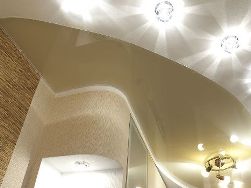 One of the stages of repairs in an apartment or a private house is the decoration of the ceiling. Before installing the ceiling, it is necessary to determine the location of the fixtures. The main task in this case is to provide the desired level of illumination in each of the rooms, while satisfying your wishes regarding their placement. In this article, we will consider the question of how to arrange lamps on the ceiling.
One of the stages of repairs in an apartment or a private house is the decoration of the ceiling. Before installing the ceiling, it is necessary to determine the location of the fixtures. The main task in this case is to provide the desired level of illumination in each of the rooms, while satisfying your wishes regarding their placement. In this article, we will consider the question of how to arrange lamps on the ceiling.
The options for the location of the fixtures, first of all, depend on their type. There are standard spotlights built-in type, as well as decorative, differing in material and version. A decorative lamp, like a chandelier, scatters the light evenly around the surface. Conventional built-in lamps, as a rule, scatter a directed beam of light, they can be of a non-rotary type or a rotary one, which allows you to direct ...
Features of installation and connection of LED lamps in a stretch ceiling
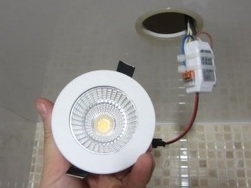 When venturing the ceiling at home or in the office, we often opt for a stretch ceiling made of PVC. And here it is important to decide in advance which fixtures to install and how many will be required. In this sense, LED spotlights are one of the most economical solutions today due to their high light output and durability.
When venturing the ceiling at home or in the office, we often opt for a stretch ceiling made of PVC. And here it is important to decide in advance which fixtures to install and how many will be required. In this sense, LED spotlights are one of the most economical solutions today due to their high light output and durability.
First of all, even before installing the stretch ceiling, they lay electrical wiring for future lighting. This is done according to a pre-designed scheme: the number of bulbs, their location, rated power. However, this process has its own peculiarities, subtleties and nuances, which will be discussed later. The number of LED fixtures is selected based on the area and purpose of the room in order to obtain sufficient illumination, and taking into account the restrictions on the heating temperature of PVC - it should not exceed 60 ° C ...
How to connect the dishwasher to the mains
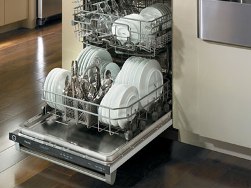 The dishwasher in the process deals with water and electricity - this is a deadly combination. Therefore, it is necessary to approach the stage of connecting the dishwasher to the mains with all responsibility, make the connection correctly so that the operation of the appliance is as safe as possible for people. At the same time, the connection must be reliable - once connected and forgot. In this article, we give recommendations that will help to properly connect the dishwasher to the mains.
The dishwasher in the process deals with water and electricity - this is a deadly combination. Therefore, it is necessary to approach the stage of connecting the dishwasher to the mains with all responsibility, make the connection correctly so that the operation of the appliance is as safe as possible for people. At the same time, the connection must be reliable - once connected and forgot. In this article, we give recommendations that will help to properly connect the dishwasher to the mains.
The dishwasher is one of the most dangerous electrical appliances in terms of electrical safety. Therefore, when connecting to the mains, it is first necessary to ensure the grounding of this appliance. That is, one of the main requirements for wiring is the presence of a working protective ground. Often they make a gross mistake - they connect a dishwasher ...
